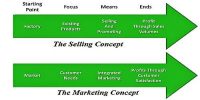Product specific, market specific or company-wide plan that describes activities involved in achieving specific marketing objectives within a set timeframe. A market plan begins with the identification (through market research) of specific customer needs and how the firm intends to fulfill them while generating an acceptable level of return. It generally includes analysis of the current market situation (opportunities and trends) and detailed action programs, budgets, sales forecasts, strategies, and projected (proforma) financial statements.
A marketing plan may be part of an overall business plan. Solid marketing strategy is the foundation of a well-written marketing plan. While a marketing plan contains a list of actions. a marketing plan without a sound strategic foundation is of little use. The written document that describes your advertising and marketing efforts for the coming year; it includes a statement of the marketing situation, a discussion of target markets and company positioning and a description of the marketing mix you intend to use to reach your marketing goals.
Contents of marketing plan:
(1) Executive Summary –
- A brief statement of goals and recommendations based on hard data. You have an abundance of freedom left in this marketing plan to detail how you’ll obtain new customers and accomplish this mission.
(2) Current Marketing Situation –
Presents data on the market, product, competition, distribution, macro-environment. (product factbook) S.P.I.N.S. Situation “Where am I”, problem identification/Implications “What is happening”, Needs Assessment “Why is it happening”, Solutions “What can I do about it”.
- Market Situation: Data on a target market, size, and growth for past years and each segment. Data on customer needs, perceptions, and buying behavior trends.
- Product Situation: Sales, prices, contribution margins and net profits for each major product line in the past several years.
- Competitive Situation: Major competitors described in terms of their size, goals, market share, product quality, marketing strategies.
- Distribution Situation: Information on the size and importance of each distribution channel.
- Macro-environment Situation: Describes broad macro-environment trends – demographic, economic, technological, political/legal, socio/cultural, that bear on a product’s future.
(3) Opportunity and Issue Analysis –
- SWOT analysis,
- Opportunities and Threats analysis,
- Strengths and Weaknesses analysis,
- Issue analysis: Use SWOT to define the main issues the plan must address.
(4) Objectives –
- Defines the plan’s financial and marketing goals in terms of sales volume, market share, and profit.
- The most common approach is to use marketing metrics. For example, your market objectives could include total market share and segments, the total number of customers and retention rate, etc.
(5) Marketing Strategy (game plan) – Broad marketing approach that will be used to achieve goals. Once you’ve indomitable your objectives and targets, it’s time to look at how you’ll promote your business to potential customers.
- Target market,
- Positioning,
- Product Line,
- Price,
- Distribution Outlets,
- Sales Force,
- Service,
- Advertising,
- Sales Promotions,
- Research and Development,
- Marketing Research.
(6) Action Programs
- Special marketing programs designed to achieve objectives, i.e., winning the loyalty of existing customers.
(7) Controls – How will the program be monitored? The marketing plan also builds assurance with financial institutions, showing lenders that your business has a good possibility of being successful.
















